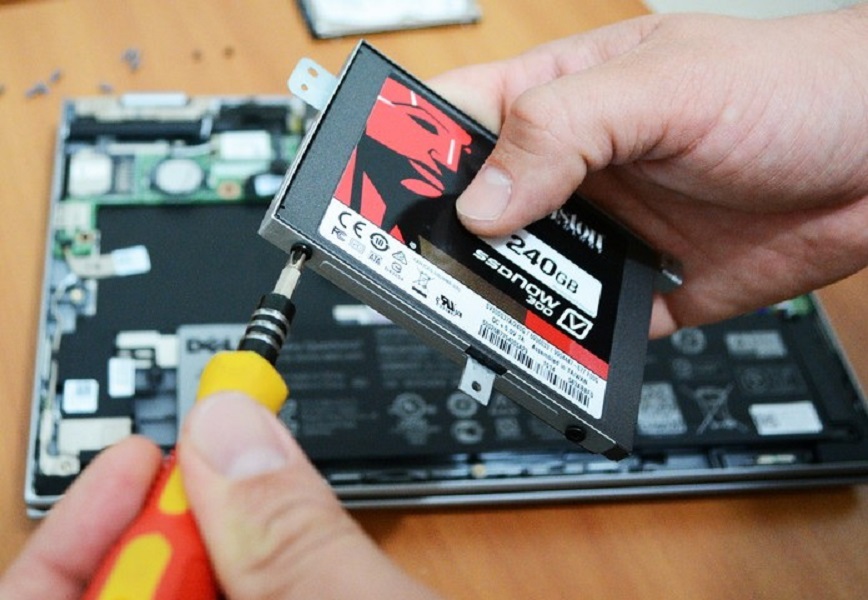solid-state drive (SSD)

solid-state drive (SSD)
A solid-state drive (SSD) is a type of data storage device that uses NAND-based flash memory to store data. Unlike traditional hard disk drives (HDDs), SSDs have no moving parts and rely on electronic circuits to read and write data. SSDs are faster, more durable, and consume less power than HDDs, making them a popular choice for use in laptops, desktops, and servers.
SSDs come in a variety of form factors, including 2.5-inch drives, mSATA, M.2, and PCIe add-in cards. They also come in different capacities, ranging from 128GB to several terabytes.
One of the main advantages of SSDs is their speed. SSDs can read and write data much faster than HDDs, which means that they can significantly improve the performance of a computer or server. SSDs are also more durable than HDDs, as they have no moving parts that can wear out over time.
Types of solid-state drive (SSD)
There are two types of solid-state drive that is external solid-state drive and internal solid-state drive;
1. external solid-state drive
An external SSD, or solid-state drive, is a storage device that connects to a computer or other device externally, typically through a USB or Thunderbolt interface. It functions similarly to an internal SSD, but can be disconnected and transported easily. External SSDs are often used to expand the storage capacity of laptops and other devices that have limited internal storage. Also to quickly transfer large files between devices. They are also commonly used as backup drives for important data. Compared to traditional hard disk drives, SSDs are faster, more reliable, and more durable due to their lack of moving parts. This makes external SSDs a popular choice for those who need high-speed storage that can withstand being transported frequently.
1.1external solid-state drive features
Here are some common features you may find in an external solid-state drive (SSD):
- Storage Capacity: External SSDs are available in a range of storage capacities, from 128GB to multiple terabytes, depending on your needs.
- Interface: External SSDs connect to your computer or other devices using various interfaces, such as USB 3.0, USB-C, Thunderbolt 3, or eSATA.
- Speed: SSDs are faster than traditional hard disk drives (HDDs) because they have no moving parts. The read/write speeds of external SSDs can vary depending on the interface used and the manufacturer’s specifications.
- Durability: Since SSDs have no moving parts, they are more durable and resistant to shock and vibration than HDDs. This makes them ideal for portable use.
- Encryption: Some external SSDs come with hardware-based encryption to protect your data from unauthorized access.
- Size and Portability: External SSDs are usually compact and lightweight, making them easy to carry around.
- Price: External SSDs are generally more expensive than traditional HDDs, but the price has come down significantly in recent years, making them more affordable for the average consumer.
2. Internal solid-state drive (SSD)
An internal solid-state drive (SSD) is a type of storage device that is installed inside a computer, laptop, or server. Like external SSDs, internal SSDs use NAND-based flash memory to store data, but they are designed to be permanently installed in a computer or server, rather than being portable.
Internal SSDs offer many advantages over traditional hard disk drives (HDDs), including faster read and write speeds, lower power consumption, and increased durability. They are also more resistant to physical shock and vibration. This makes them ideal for use in laptops and other mobile devices.
Internal SSDs come in a variety of form factors, including the common 2.5-inch form factor used in laptops, as well as the smaller mSATA and M.2 form factors used in ultrabooks and other compact devices. They are also available in larger form factors such as the 3.5-inch form factor used in desktop computers and servers.
One of the main advantages of internal SSDs is their speed. Because they have no moving parts, they can read and write data much faster than HDDs. This can significantly improve the performance of a computer or server. Internal SSDs also consume less power than HDDs, which can help to extend the battery life of laptops and other mobile devices.
2.1 INTERNAL solid-state drive (SSD) TYPES
Internal solid-state drives (SSDs) come in a variety of types and form factors. Some of the most common types of internal SSDs are:
- SATA SSDs: SATA SSDs are the most common type of internal SSD. They use the same interface as traditional hard disk drives (HDDs). They are available in the 2.5-inch form factor and can be easily installed in most laptops and desktops.
- PCIe SSDs: PCIe SSDs use the PCIe interface to connect to a computer’s motherboard, providing faster speeds than SATA SSDs. They are available in different form factors, such as add-in cards or M.2 SSDs, and are commonly used in high-performance desktops and workstations.
- M.2 SSDs: M.2 SSDs are a newer type of internal SSD that use the M.2 form factor. They connect to a computer’s motherboard using PCIe or SATA interfaces and are commonly used in ultrabooks, tablets, and other compact devices.
- NVMe SSDs: NVMe (Non-Volatile Memory Express) SSDs use a newer protocol optimized for PCIe SSDs. They provide even faster read and write speeds than traditional PCIe SSDs. They are available in the M.2 form factor. They are commonly used in high-performance laptops, gaming computers, and workstations.
- U.2 SSDs: U.2 SSDs use the U.2 interface to connect to a computer’s motherboard and are commonly used in enterprise-level servers and data centers.
The choice of internal SSD type will depend on factors such as the application, budget, and compatibility with the computer or server in question. In general, PCIe and NVMe SSDs offer the fastest speeds and are best suited for high-performance applications. While SATA SSDs offer a good balance of speed and affordability and are suitable for most general-purpose computing needs.
Comparison of solid-state drive (SSD) and hard disk drive (HDD)
Solid-state drives (SSDs) and hard disk drives (HDDs) both serve the purpose of storing data in a computer or other device, but there are significant differences between the two technologies. Here are some of the main differences between SSDs and HDDs:
- Speed: SSDs are much faster than HDDs, with significantly faster read and write speeds. This results in faster boot times, faster application load times, and generally snappier performance.
- Durability: SSDs have no moving parts, which makes them less susceptible to physical damage from drops, impacts, or vibration. HDDs, on the other hand, have spinning platters and a moving read/write head, which makes them more susceptible to mechanical failure.
- Power efficiency: SSDs consume less power than HDDs, which can result in longer battery life for laptops and other mobile devices.
- Capacity: HDDs are available in larger capacities than SSDs and are generally more cost-effective per gigabyte of storage. However, SSDs are catching up in capacity and their prices are becoming more competitive.
- Noise: SSDs produce less noise than HDDs, since they do not have any moving parts.
- Reliability: SSDs use advanced error correction algorithms to ensure data integrity and prevent data loss. However, the lifespan of SSDs is limited by the number of read and write cycles, while HDDs have a longer lifespan.
Why do you need solid-state drive (SSD)
Solid-state drives (SSDs) offer several benefits over traditional hard disk drives (HDDs). This makes them a desirable option for many computer users. Here are some of the main reasons why you might want to consider using an SSD:
- Faster speeds: SSDs are much faster than HDDs, with significantly faster read and write speeds. This results in faster boot times, faster application load times, and snappier performance.
- Improved durability: SSDs have no moving parts, which makes them less susceptible to physical damage from drops, impacts, or vibration. This can be particularly important for laptops and other mobile devices that are frequently on the move.
- Better power efficiency: SSDs consume less power than HDDs, which can result in longer battery life for laptops and other mobile devices.
- Quieter operation: SSDs produce less noise than HDDs, since they do not have any moving parts.
- More compact form factor: SSDs are available in smaller form factors than HDDs. This makes them ideal for use in ultrabooks, tablets, and other compact devices.
- Better data reliability: SSDs use advanced error correction algorithms to ensure data integrity and prevent data loss.
Overall, SSD can significantly improve the performance, durability, and efficiency of your computer or mobile device. This makes it a worthwhile investment for many users. Whether you are a gamer, professional, or casual user, SSD can provide a noticeable improvement in speed and reliability
Conclusion on solid-state drive (SSD)
In conclusion, solid-state drives (SSDs) offer several advantages over traditional hard disk drives (HDDs) and have become increasingly popular in recent years. SSDs are much faster than HDDs, have no moving parts, consume less power, produce less noise, and are generally more reliable. They also come in smaller form factors, making them ideal for use in ultrabooks, tablets, and other compact devices. While SSDs are generally more expensive than HDDs, their prices have come down in recent years and they are now becoming more affordable. Overall, if you are looking to upgrade your computer or mobile device, SSD is definitely worth considering for improved performance, durability, and efficiency.
